 | ||
Similar Lever House, Bunshaft Residence, Greenland Group Suzhou C, Kingtown International Center, Carmelo K Anthony Basketbal | ||
The Manufacturers Trust Company Building, now known as 510 Fifth Avenue, is a historic building located at the southwest corner of West 43rd Street and Fifth Avenue in the New York City borough of Manhattan.
Contents
- Building history
- Building modifications and controversy
- Ownership and tenancy
- Bertoia sculpture
- Design awards
- References
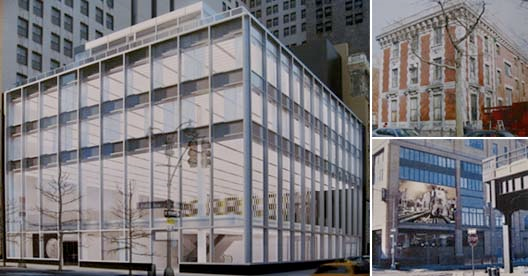
Considered "the very model of Modernism" in architecture, the Midtown Manhattan building is a designated New York City landmark, and is considered "an important, historic building in the same league as modern architectural legends like Lever House and the Seagram Building." The AIA Guide to New York City calls it "a glass-sheathed supermarket of dollars," and the building's glass design has been called a "metaphor for honesty and transparency in banking" and "symbol of a self-confident era" which influenced commercial architecture.
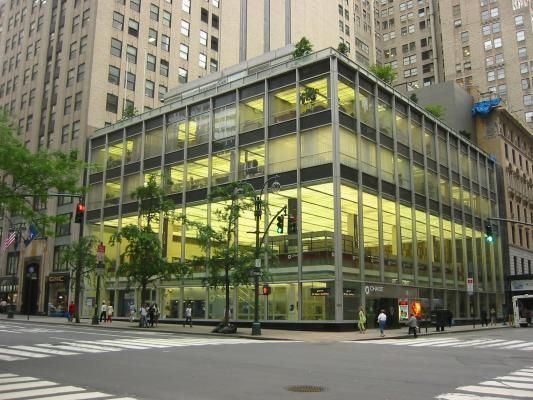
Building history

The glass-and-aluminum building was completed and opened in 1954. It was built as a bank for the Manufacturers Trust Company, which later merged with the Central Hanover Bank & Trust to form Manufacturers Hanover Corporation. Charles Evans Hughes III and Gordon Bunshaft of Skidmore, Owings & Merrill designed the building, assisted by Patricia W. Swan and Roy O. Allen; Hughes won an internal company design competition to be awarded the project. The interior design was done by Eleanor H. Le Maire.
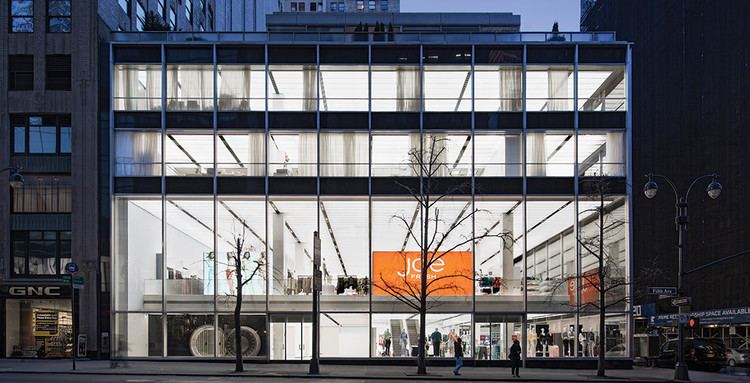
The four-story building is the first bank building in the United States to be built in the International Style, and has been described by the New York Times as a "luminous box with an unbroken glass facade." Among its most notable features is a seven-foot-wide circular metal Mosler bank vault door on its first floor, visible from the street through the windows, which originally opened to a 30-ton stainless-steel vault. It is this feature that caused the AIA Guide to remark that the building "led the banking profession out of the cellar and onto the street."
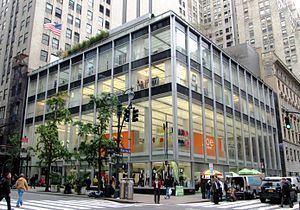
In 1997, the New York City Landmarks Preservation Commission voted to grant landmark protection to the building's exterior, and in 2011 also designated the building's mid-century modern interior as a landmark. In designating the interior as a landmark, Commission chairman Robert B. Tierney said that the building's "luminous ceilings, spacious floor plans, white marble piers and other minimalist features blur the distinction between inside and out."
Building modifications and controversy
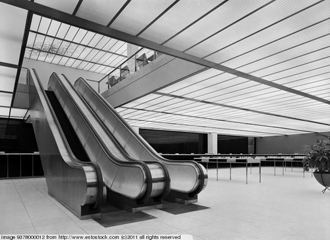
In 2011, a dispute between preservationists and building owner Vornado Realty Trust over the building led to a suit in court. Vornado received permission from the Landmarks Preservation Commission to modify the building to create a space to accommodate two new stores on Fifth Avenue; the project called for cutting new doorways into the facade, rotating the escalators to move them farther away from the windows, and reducing the vault wall. Vornado hired the original architects, Skidmore, Owings & Merrill, to make the changes. Tenants in the building at the time included Bloomberg L.P., the company of New York City mayor Michael Bloomberg.
Preservationists criticized the project as damaging to a significant building and suggested that this was part of a pattern of city government unduly favoring developers, while the building's owner and others argued that the project were consistent with and showed respect for the property. Architecture critic Ada Louise Huxtable of the Wall Street Journal criticized the project as a "travesty" and "conversion to generic commercial space," expressing particular criticism of the removal of the Bertoia screen from the site. In 2011, 510 Fifth Avenue was added to the World Monuments Fund's 2012 "watch list" of endangered buildings. DOCOMOMO – the organization for Documentation and Conservation of Buildings, Sites and Neighborhoods of the Modern Movement – and a coalition of preservationist organizations brought a lawsuit against Vornado,
seeking to prove that the Certificate of Appropriateness issued by the Landmarks Preservation Commission compromised the Landmark-worthy qualities the Commission agreed to protect with its exterior and interior designations. A settlement of the suit yielded some more stringent requirements concerning the vault walls and the partitions dividing the two retail spaces, and it laid the groundwork for the return of the two Bertoia sculptures, which had previously been removed as property of Chase Bank.
...The completed alterations exhibit some respect for the buildings landmark architectural qualities. The entry doors from Fifth Avenue are minimally detailed and fit within the original street-wall framing. Divisions between the two retail spaces are of clear glass for the first several feet behind the glazed facade to minimize their visual presence. The luminous ceilings, which had suffered decades of ad hoc modifications, have been replaced with up-to-date components that accurately replicate the original appearance. And the Bertoia works are reinstalled in appropriate locations where they can be appreciated.
The settlement was agreed to in February 2012. Following the conclusion of the renovation, Skidmore, Owings & Merrill listed the site area as 12,522 square feet (1,163.3 m2), the project area as 30,000 square feet (2,800 m2), and the building height at 74 square feet.
Ownership and tenancy
The building was originally owned by the Manufacturers Trust Company, which merged with Central Hanover Bank & Trust Company (Hanover Trust) to become Manufacturers Hanover Trust Company, which in turn merged with Chemical Bank, which was absorbed into Chase Manhattan and is now JPMorgan Chase & Company. Manufacturers Hanover acquired full ownership of the land underlying the building from the Mutual Life Insurance Company of New York in February 1992. In 2000 or 2001, Chase sold the building to Tahl Propp Equities, but retained ownership of the Bertoia sculptures. The Vornado Realty Trust acquired the property in 2009. In 2010, Chase closed its bank branch in the building.
The flagship Joe Fresh store has occupied 14,000 square feet of retail space on the ground floor and second-floor mezzanine since it opened in 2012.
Bertoia sculpture
Artist Harry Bertoia was commissioned to create a "floating" or sculptural screen of 800 intersecting brass, copper and nickel panels in the lobby that now serves as the backdrop for the Joe Fresh store. Described as a "midcentury masterwork" and "the three-dimensional equivalent" of a Jackson Pollock painting, the piece, entitled Golden Arbor, is 70 feet long and 16 feet high, with a weight of 5.25 tons.
The piece was removed from the lobby when JPMorgan Chase closed its branch, over the protests of preservationists. It returned two years later, after being cleaned and restored, as part of the settlement under which Chase retained ownership of the piece but agreed to place it on indefinite loan for public display in its original home for as long as 510 Fifth Avenue retains landmark status.
Design awards
The building's original design received the Architectural League of New York Gold Medal for Architecture and Municipal Art Society's Plaque of Commendation in 1955, and the Fifth Avenue Association's Award for Excellence in 1956. The 2012 renovation and adaptive reuse received a 2013 American Institute of Architects New York City Chapter Design Award and a 2013 Architectural Record "Good Design is Good Business" award.
